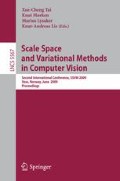Abstract
Modelling the morphological processes of dilation and erosion with convex structuring elements with partial differential equations (PDEs) allows for digital scalability and subpixel accuracy. However, numerical schemes suffer from blur by dissipative artifacts. In our paper we present a family of so-called flux-corrected transport (FCT) schemes that addresses this problem for arbitrary convex structuring elements. The main characteristics of the FCT-schemes are: (i) They keep edges very sharp during the morphological evolution process, and (ii) they feature a high rotational invariance. Numerical experiments with diamonds and ellipses as structuring elements show that FCT-schemes are superior to standard schemes in the field of PDE-based morphology.
Access this chapter
Tax calculation will be finalised at checkout
Purchases are for personal use only
Preview
Unable to display preview. Download preview PDF.
References
Serra, J.: Echantillonnage et estimation des phénomènes de transition minier. PhD thesis, University of Nancy, France (1967)
Matheron, G.: Eléments pour une théorie des milieux poreux. Masson, Paris (1967)
Boris, J.P., Book, D.L.: Flux corrected transport. I. SHASTA, a fluid transport algorithm that works. Journal of Computational Physics 11(1), 38–69 (1973)
Matheron, G.: Random Sets and Integral Geometry. Wiley, New York (1975)
Boris, J.P., Book, D.L.: Flux corrected transport. III. Minimal error FCT algorithms. Journal of Computational Physics 20, 397–431 (1976)
Serra, J.: Image Analysis and Mathematical Morphology, vol. 1. Academic Press, London (1982)
Hairer, E., Norsett, S., Wanner, G.: Solving Ordinary Differential Equations. I: Nonstiff Problems. Springer Series in Computational Mathematics, vol. 8. Springer, New York (1987)
Serra, J.: Image Analysis and Mathematical Morphology, vol. 2. Academic Press, London (1988)
Osher, S., Sethian, J.A.: Fronts propagating with curvature-dependent speed: Algorithms based on Hamilton–Jacobi formulations. Journal of Computational Physics 79, 12–49 (1988)
Brockett, R.W., Maragos, P.: Evolution equations for continuous-scale morphology. In: Proc. IEEE International Conference on Acoustics, Speech and Signal Processing, San Francisco, CA, March 1992, vol. 3, pp. 125–128 (1992)
van den Boomgaard, R.: Mathematical Morphology: Extensions Towards Computer Vision. PhD thesis, University of Amsterdam, The Netherlands (1992)
Rouy, E., Tourin, A.: A viscosity solutions approach to shape-from-shading. SIAM Journal on Numerical Analysis 29, 867–884 (1992)
Sapiro, G., Kimmel, R., Shaked, D., Kimia, B.B., Bruckstein, A.M.: Implementing continuous-scale morphology via curve evolution. Pattern Recognition 26(9), 1363–1372 (1993)
Alvarez, L., Guichard, F., Lions, P.L., Morel, J.M.: Axioms and fundamental equations in image processing. Archive for Rational Mechanics and Analysis 123, 199–257 (1993)
Arehart, A.B., Vincent, L., Kimia, B.B.: Mathematical morphology: The Hamilton–Jacobi connection. In: Proc. Fourth International Conference on Computer Vision, Berlin, pp. 215–219. IEEE Computer Society Press, Los Alamitos (1993)
Siddiqi, K., Kimia, B.B., Shu, C.W.: Geometric shock-capturing ENO schemes for subpixel interpolation, computation and curve evolution. Graphical Models and Image Processing 59, 278–301 (1997)
Heijmans, H.J.A.M., Roerdink, J.B.T.M. (eds.): Mathematical Morphology and its Applications to Image and Signal Processing. Computational Imaging and Vision, vol. 12. Kluwer, Dordrecht (1998)
Soille, P.: Morphological Image Analysis, 2nd edn. Springer, Berlin (2003)
van den Boomgaard, R.: Numerical solution schemes for continuous-scale morphology. In: Nielsen, M., Johansen, P., Olsen, O.F., Weickert, J. (eds.) Scale-Space 1999. LNCS, vol. 1682, pp. 199–210. Springer, Heidelberg (1999)
Sethian, J.A.: Level Set Methods and Fast Marching Methods, 2nd edn. Cambridge University Press, Cambridge (1999)
Goutsias, J., Vincent, L., Bloomberg, D.S. (eds.): Mathematical Morphology and its Applications to Image and Signal Processing. Computational Imaging and Vision, vol. 18. Kluwer, Dordrecht (2000)
Talbot, H., Beare, R. (eds.): Proc. Sixth International Symposium on Mathematical Morphology and its Applications, Sydney, Australia (April 2002), http://www.cmis.csiro.au/ismm2002/proceedings/
LeVeque, R.J.: Finite Volume Methods for Hyperbolic Problems. Cambridge University Press, Cambridge (2002)
Osher, S., Fedkiw, R.P.: Level Set Methods and Dynamic Implicit Surfaces. Applied Mathematical Sciences, vol. 153. Springer, New York (2002)
Ronse, C., Najman, L., Decencière, E. (eds.): Mathematical Morphology: 40 Years On. Computational Imaging and Vision, vol. 30. Springer, Dordrecht (2005)
Breuß, M., Weickert, J.: A shock-capturing algorithm for the differential equations of dilation and erosion. Journal of Mathematical Imaging and Vision 25, 187–201 (2006)
Breuß, M., Welk, M.: Analysis of staircasing in semidiscrete stabilised inverse linear diffusion algorithms. Journal of Computational and Applied Mathematics 206, 520–533 (2007)
Author information
Authors and Affiliations
Editor information
Editors and Affiliations
Rights and permissions
Copyright information
© 2009 Springer-Verlag Berlin Heidelberg
About this paper
Cite this paper
Breuß, M., Weickert, J. (2009). Highly Accurate PDE-Based Morphology for General Structuring Elements. In: Tai, XC., Mørken, K., Lysaker, M., Lie, KA. (eds) Scale Space and Variational Methods in Computer Vision. SSVM 2009. Lecture Notes in Computer Science, vol 5567. Springer, Berlin, Heidelberg. https://doi.org/10.1007/978-3-642-02256-2_63
Download citation
DOI: https://doi.org/10.1007/978-3-642-02256-2_63
Publisher Name: Springer, Berlin, Heidelberg
Print ISBN: 978-3-642-02255-5
Online ISBN: 978-3-642-02256-2
eBook Packages: Computer ScienceComputer Science (R0)

